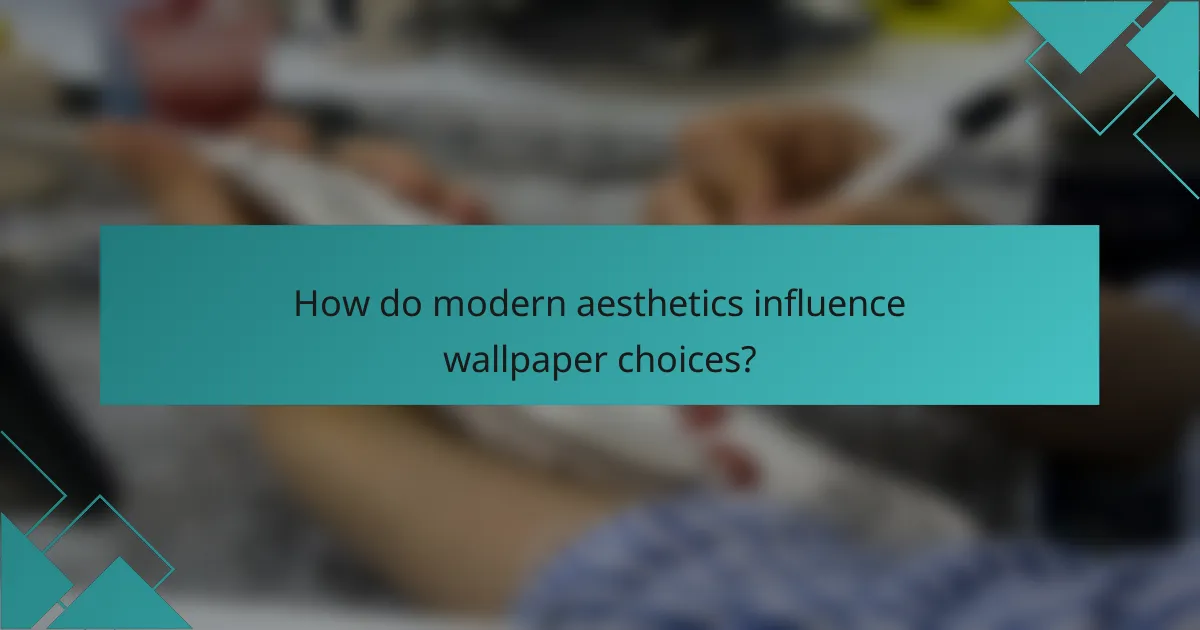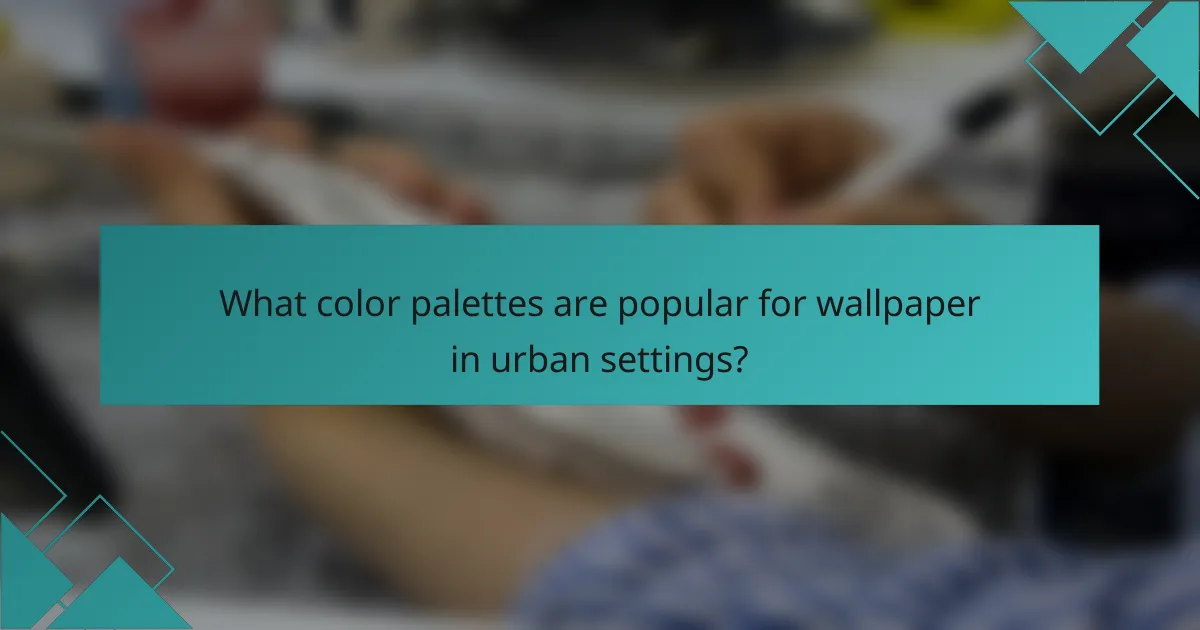In 2023, wallpaper design trends are embracing modern aesthetics through the integration of natural elements, bold colors, and unique textures. Homeowners and designers are drawn to clean lines and cohesive color palettes that reflect contemporary styles, while earthy tones and vibrant jewel shades bring warmth and personality to urban interiors.

What are the latest wallpaper design trends in 2023?
The latest wallpaper design trends in 2023 focus on integrating natural elements, bold colors, and unique textures to create modern aesthetics. These trends reflect a desire for personalization and a connection to nature, while also embracing geometric and vintage influences.
Biophilic design elements
Biophilic design elements in wallpaper emphasize the connection between indoor spaces and nature. This trend includes patterns that feature botanical motifs, landscapes, and organic shapes, which can create a calming atmosphere. Using wallpapers with natural imagery can enhance well-being and bring a refreshing vibe to any room.
When selecting biophilic wallpaper, consider options that incorporate earthy tones and textures that mimic natural materials. For example, wallpapers that resemble wood or stone can add depth and warmth to your space.
Geometric patterns
Geometric patterns are making a strong comeback in wallpaper design, characterized by bold shapes and clean lines. These designs can create a modern and dynamic look, suitable for both accent walls and entire rooms. Popular geometric styles include chevrons, hexagons, and abstract shapes that add visual interest.
To effectively use geometric patterns, choose a color palette that complements your existing decor. Consider using these wallpapers in smaller spaces, like powder rooms or entryways, to create a striking focal point without overwhelming the area.
Textured finishes
Textured finishes in wallpaper provide a tactile experience that enhances the visual appeal of a room. Options like embossed, linen, or grasscloth wallpapers add depth and dimension, making walls feel more inviting. These textures can also help to mask imperfections in the wall surface.
When selecting textured wallpaper, think about how the finish will interact with light in the room. Textured surfaces can create shadows and highlights, adding to the overall ambiance. It’s essential to consider the maintenance of these finishes, as some may require more care than standard flat wallpapers.
Bold color contrasts
Bold color contrasts are a key trend in wallpaper design, allowing for striking combinations that energize a space. This approach often involves pairing dark hues with bright accents, creating a dramatic effect that draws attention. Popular color pairings include navy with mustard or emerald green with coral.
To incorporate bold contrasts, choose one or two key colors and use them strategically throughout the room. Accent walls or statement pieces can help balance the intensity of the colors, ensuring the space remains cohesive and inviting.
Vintage-inspired designs
Vintage-inspired designs in wallpaper draw from past eras, featuring intricate patterns and nostalgic motifs. These designs can evoke a sense of history and charm, making them ideal for creating cozy, inviting spaces. Common vintage elements include floral prints, damask patterns, and retro color schemes.
When using vintage-inspired wallpaper, consider the overall style of your home. Mixing vintage patterns with modern furnishings can create an eclectic look, while pairing them with traditional decor can enhance the classic feel. Be mindful of scale; larger patterns can overwhelm small spaces, while smaller prints can add subtle interest.

How do modern aesthetics influence wallpaper choices?
Modern aesthetics significantly shape wallpaper selections by emphasizing simplicity, functionality, and visual appeal. Homeowners and designers often prioritize clean lines, subtle textures, and cohesive color palettes that reflect contemporary trends.
Minimalist styles
Minimalist wallpaper designs focus on simplicity and functionality, often featuring solid colors or subtle patterns. These wallpapers create a serene environment, making spaces feel larger and more open. When choosing minimalist styles, consider neutral tones like whites, grays, and beiges to maintain a clean aesthetic.
To enhance a minimalist look, opt for wallpapers with matte finishes, as they provide a soft texture without overwhelming the senses. Avoid busy patterns or excessive colors, which can detract from the minimalist approach.
Industrial chic
Industrial chic wallpaper draws inspiration from urban environments, incorporating elements like exposed brick, concrete textures, and metallic finishes. This style often features darker color palettes, such as deep grays and blacks, paired with warm wood tones to create a balanced atmosphere.
When selecting industrial chic wallpaper, consider designs that mimic raw materials, as they add character and depth to a space. Pair these wallpapers with minimalistic furniture to maintain a cohesive look that embraces both industrial and modern aesthetics.
Scandinavian influences
Scandinavian wallpaper designs emphasize functionality, simplicity, and natural elements, often featuring light colors and organic patterns. This style promotes a cozy and inviting atmosphere, making it ideal for homes seeking warmth and comfort.
When choosing Scandinavian-inspired wallpaper, look for designs that incorporate soft pastels or earthy tones, along with geometric or nature-inspired patterns. These elements work together to create a harmonious environment that reflects the essence of Scandinavian design.

What color palettes are popular for wallpaper in urban settings?
In urban settings, popular wallpaper color palettes often reflect contemporary aesthetics and the surrounding environment. Earthy tones, pastel shades, and vibrant jewel tones are commonly chosen for their ability to enhance modern interiors while maintaining a sense of warmth and style.
Earthy tones
Earthy tones, such as terracotta, olive green, and warm beige, create a grounded atmosphere in urban spaces. These colors evoke a connection to nature, making them ideal for city dwellers seeking tranquility amidst the hustle and bustle. When selecting earthy wallpapers, consider textures that mimic natural materials, like linen or stone, to enhance the organic feel.
Combining earthy tones with natural wood accents or plants can further elevate the aesthetic. This palette works well in living rooms and bedrooms, providing a cozy yet sophisticated backdrop.
Pastel shades
Pastel shades, including soft pinks, light blues, and mint greens, are popular for their calming effect and ability to brighten small urban spaces. These colors can make a room feel more open and airy, which is particularly beneficial in compact apartments. When using pastels, consider pairing them with white or light-colored furniture to maintain a fresh and cohesive look.
Pastel wallpapers can also be used to create accent walls, adding a subtle pop of color without overwhelming the space. This approach allows for flexibility in decor styles, from modern to vintage.
Vibrant jewel tones
Vibrant jewel tones, such as sapphire blue, emerald green, and ruby red, add a touch of luxury and drama to urban interiors. These rich colors can serve as statement pieces, drawing attention and creating focal points in a room. When incorporating jewel tones, balance them with neutral furnishings to prevent the space from feeling too heavy.
Using jewel-toned wallpaper in dining areas or living rooms can create an inviting atmosphere for entertaining. Consider patterns or textures that reflect light, enhancing the opulence of these colors while maintaining a modern edge.

How do textures enhance wallpaper design?
Textures significantly enhance wallpaper design by adding depth and visual interest, making spaces feel more dynamic. They can create a tactile experience that influences the overall ambiance of a room, allowing for a more personalized aesthetic.
Textured vinyl options
Textured vinyl wallpapers are durable and easy to clean, making them ideal for high-traffic areas like kitchens and bathrooms. They come in various patterns, including faux brick, wood, and fabric-like finishes, allowing homeowners to achieve a specific look without the maintenance of real materials.
When selecting textured vinyl, consider the thickness and pattern depth. Thicker options can hide wall imperfections better but may be more challenging to install. Look for options that are moisture-resistant if applying in humid environments.
Fabric-backed wallpapers
Fabric-backed wallpapers offer a luxurious feel and are often used in upscale interiors. The fabric layer provides added durability and can help with sound absorption, making them suitable for bedrooms or media rooms.
These wallpapers are typically more expensive than standard vinyl, so budget accordingly. Ensure proper installation to avoid issues with peeling or bubbling, as they can be less forgiving than other materials.
3D embossed patterns
3D embossed patterns create a striking visual effect by adding physical texture that catches light and shadows, enhancing the room’s depth. These wallpapers can range from subtle designs to bold statements, suitable for accent walls or entire rooms.
When choosing 3D embossed wallpapers, consider the room’s lighting, as it can dramatically affect how the textures appear. Installation may require professional help to ensure that the patterns align correctly and maintain their integrity over time.

What are the key considerations for selecting wallpaper?
Selecting wallpaper involves evaluating several key factors to ensure it complements your space effectively. Consider the room’s function, lighting conditions, and the durability and maintenance requirements of the wallpaper material.
Room function
The function of a room significantly influences wallpaper selection. For example, in high-traffic areas like hallways or children’s rooms, opt for durable materials that can withstand wear and tear. Conversely, in spaces like bedrooms or home offices, softer colors and textures can create a calming atmosphere.
Additionally, consider the mood you want to evoke. Bright, vibrant patterns may energize a living room, while subtle, muted designs may be more suitable for a relaxing bedroom environment.
Lighting conditions
Lighting plays a crucial role in how wallpaper appears in a room. Natural light can enhance colors and patterns, making them appear more vibrant, while artificial lighting may alter their perception. Test wallpaper samples in the actual lighting conditions of your space to see how they look at different times of the day.
For rooms with limited natural light, lighter colors can help brighten the space, while darker shades may create a cozy, intimate feel. Consider the direction of your windows as well; north-facing rooms may benefit from warmer tones to counteract cooler light.
Durability and maintenance
Durability and maintenance are essential factors when selecting wallpaper, especially in areas prone to moisture or stains, such as kitchens and bathrooms. Vinyl wallpapers are often recommended for these spaces due to their water-resistant properties and ease of cleaning.
For less demanding environments, paper-based wallpapers can be suitable but may require more care. Always check the manufacturer’s recommendations regarding cleaning methods and potential exposure to moisture to ensure longevity.
